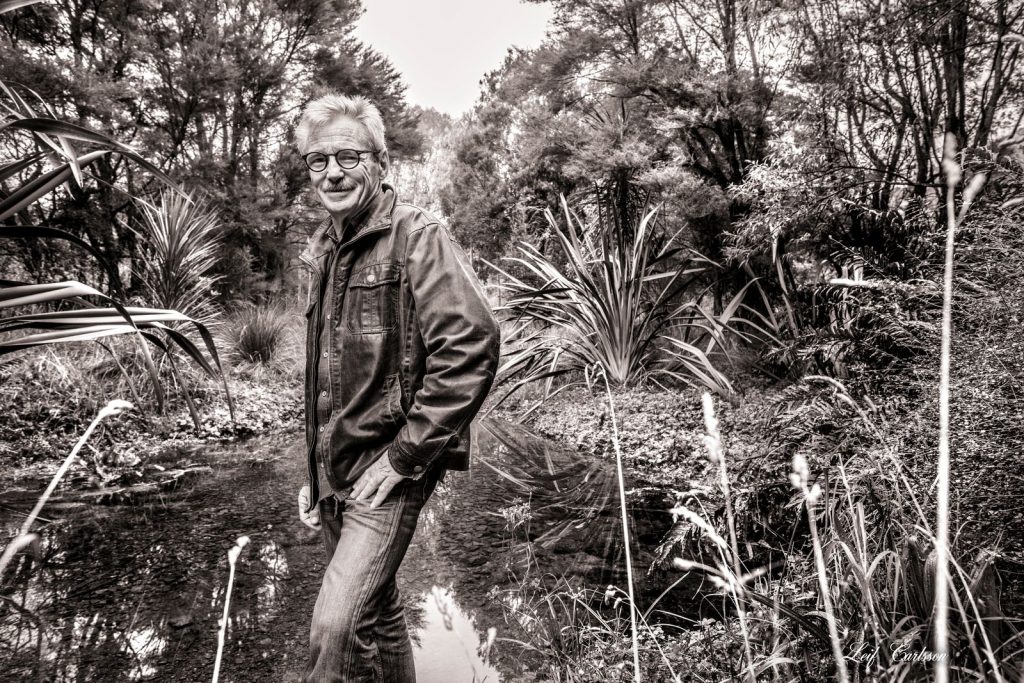Image: Clive Paton. Photo: copyright Leif Carlsson
Ata Rangi vineyard celebrates 40 years this year, but it’s business as usual for co-founder Clive Paton, who spends his mornings doing the hard yards at the native bush block he has restored.
“I’d always spent a lot of time in the bush,” Paton explains. His mother’s Waikato farmhouse boasted about five acres of trees around the farmhouse.
It was only in later years in Martinborough when Paton could begin to replicate the bush surrounds. But planting on his own piece of land, the five hectares of stony paddock on which Ata Rangi was founded in 1980, was not sufficient for long—and of course, the priority use for the vineyard needed to be wine production.
Paton’s sister Alison soon joined the team with a two hectare block adjoining his. This was planted in Pinot Noir: the grape that would earn Ata Rangi international acclaim. It wasn’t, however, satisfying Paton’s conservationist drive.
“In town, I was at the point where I was needing to chop down trees in order to plant trees. So I began to search for a piece of land to cover with natives,” he said.
The acquisition of the ‘bush block’, as it is now fondly known, began with the grapes. While viewing potential grape land with a real estate agent, Paton came across a piece of destroyed original bush, close to 300 acres, up the back of the property.
“Straight away, I knew I wouldn’t find another piece of land like it so close to Martinborough,” he said.
Fencing, pest control and planting out the block was no small feat. It now boasts around 700,000 trees: mostly native varieties, with some eucalypts and others that are useful for the sustainable management of Ata Rangi. The tree perhaps dearest to Paton’s heart, though, is the rātā.
“A DOC friend staying in the bush block hut for the weekend went up the ridge and discovered rātā, which were thought to be totally extinct in the area. The Metrosideros family in New Zealand doesn’t have the resilience against possums of its Australian relatives,” he said.
“One day I went up there just before Christmas and the rātā were flowering. There would’ve been 500 tūī in there. It was like walking past the Cake Tin when there was a game on: a huge roar. It was incredible. So I decided to propagate them and start planting through my areas.”
The Project Crimson Trust, initiated to protect the pōhutukawa and rātā, was a natural partner for Clive in the rātā propagation process.
“I’m not a scientist, but I know how to use science,” Clive says. “The board from Project Crimson Trust came for a field day in around 2005, and I was so inspired by their work. Some became very good friends. I’ve never looked back.”
“It’s a similar camaraderie to what you find in the pinot industry. You have to be slightly crazy to be a pinot noir producer, and it links everybody. It’s the same in conservation. Once you know people are interested in the environment, you become friends pretty quickly.”
Clive’s work with rātā has also played a vital role in forging the identity of his business.
“There’s always a pottle of baby rātā on the table, and we’ve sold thousands from the wine shop over the years. It’s part of our marketing: but more than that, it’s who we are.”
Ata Rangi favours small tasting groups over larger open days, allowing Clive to tell the story of his conservation work to twenty or so guests as they enjoy Ata Rangi’s exquisite vintages.
The renowned wines include “Crimson”, a younger vine pinot noir named for the Trust and sold in support of its work. The proceeds from ‘Crimson’ have supported Project Crimson for decades, and the wine will receive a fresh look label this year.
Recently, Ata Rangi has also supported Project Crimson initiative Trees That Count, with over 350 native trees funded for planting groups across New Zealand. The business’ financial support of Trees That Count is not able to continue this year due to the impacts of COVID-19, but Clive—and Ata Rangi—remain committed to raising awareness for the cause in any possible form, and resuming monetary support when international markets revive.
Clive received the ONZM for his services to the environment in 2012 and the Loder Cup in 2014: but far from resting on his laurels, his work only continues to grow. The Aorangi Conservation Trust he founded looks after around 40,000 hectares behind the beloved bush block.
Presently, his Pūkaha to Kawakawa Alliance group provides connectivity between groups such as the Department of Conservation and Greater Wellington Regional Council, and works to secure funding for conservation work across the Wairarapa region.
“I don’t even think about it,” admits Clive when questioned about his motivation for his dedicated work. “I love planting things, I love the bush, I love the people who love the bush.”
“We have a vehicle to have a bit of influence through Ata Rangi, with thousands of individual customers who’ve come across our love of rātā and pōhutukawa. The work is wider than that, too: there’s a whole generation that’s reacting to what has happened to New Zealand’s flora and fauna.”
“We’re not going to see the change in our lifetime, but we’re setting it up for our children and grandchildren to keep going. It’s a multi-generational problem, and solution. We can never repair the damage done, but we can have a pretty good crack at making things a lot better: and at looking after what we have left.”
Are you a Daily Wine News subscriber? If not, click here to join our mailing list. It’s free!
















